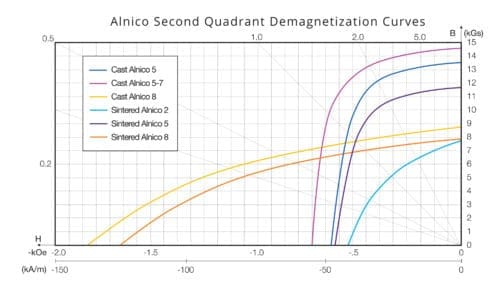Alnico alloys consist of aluminum, nickel, cobalt, copper, and iron. Some grades have titanium and some manufactures also use additions of silicon, columbium zirconium, or other elements to enhance the magnetic properties.
These alloys are formed by foundry processes as previously noted. The magnetic performance is developed by heat-treating the castings. The heat treat process for most of the grade includes the application of a magnetic field to produce domain alignment. The magnetic properties of some typical alnico alloys are as follows:
|
Grade |
Br (Gs) |
Hci (Oe) |
Hc (Oe) |
BHmax (MGOe) |
Max Op Temp |
TC of Br %/˚C |
TC of Hci %/˚C |
|---|---|---|---|---|---|---|---|
|
Cast Alnico 2 |
7500 |
580 |
560 |
1.7 |
550˚C/1020˚F |
-0.02 |
– |
|
Cast Alnico 3 |
7000 |
500 |
480 |
1.35 |
550˚C/1020˚F |
-0.02 |
– |
|
Cast Alnico 5 |
12800 |
640 |
640 |
5.5 |
550˚C/1020˚F |
-0.02 |
– |
|
Cast Alnico 5-7 |
13500 |
740 |
740 |
7.5 |
550˚C/1020˚F |
-0.02 |
– |
|
Cast Alnico 8 |
8200 |
1860 |
1650 |
5.3 |
550˚C/1020˚F |
-0.02 |
– |
|
Cast Alnico 9 |
10600 |
1500 |
1500 |
9.0 |
550˚C/1020˚F |
-0.02 |
– |
|
Sintered Alnico 2 |
7100 |
570 |
550 |
1.5 |
450˚C/840˚F |
-0.02 |
– |
|
Sintered Alnico 5 |
10900 |
630 |
620 |
3.9 |
450˚C/840˚F |
-0.02 |
– |
|
Sintered Alnico 8 |
7400 |
1690 |
1500 |
4.0 |
450˚C/840˚F |
-0.02 |
– |
The anisotropic alloys are heat treated in a magnetic field and thus develop a preferred direction of orientation. They only achieve the properties shown when magnetized in this direction.
The isotropic materials are heat treated but not in a magnetic field and are capable of being magnetized in any direction and should exhibit the properties shown regardless of the magnetizing direction.
SINTERED ALNICO:
These alloys are produced using powder metallurgy techniques. The metal powders are mixed together in the proper proportions and then compacted in a die (which is hardened steel and carbide with a cavity the shape of the part to be pressed). After compaction the parts are sintered. The sintering process takes the compacts to a temperature near to the melting point to achieve the final densification of the material. After sintering the parts must still be heat treated to properly develop the magnetic properties. Sintered materials do have much better tensile and transverse rupture strength than cast materials.
Refer to chart of typical magnetic properties for sintered alnico properties.
Alnico magnets, cast and sintered, are finished ground using abrasive grinding to produce the final shape and tolerance. Once ground the material is a shiny metallic finish. These materials are brittle and cannot be machined or drilled.
|
Property |
Unit of Measure |
Value for Sintered Alnico |
Value for Cast Alnico |
|---|---|---|---|
|
Vickers Hardness |
Hv |
440 |
440-620 |
|
Density |
g/cm3 |
6.8 – 7.0 |
6.9 – 7.3 |
|
Curie Temp TC |
°C |
810 – 860 |
740 – 860 |
|
Curie Temp TF |
°F |
1,400 – 1,580 |
1,460 – 1,580 |
|
Specific Resistance |
μΩ⋅Cm |
50- 70 |
45 – 75 |
|
Bending Strength |
kN/mm2 |
0.35 – 0.76 |
0.05 – 0.31 |
|
Tensile Strength |
kN/mm2 |
0.35- 0.45 |
0.02 – 0.15 |
|
Thermal Expansion |
°C-1 |
+11.0 to +12.4 x10-6 |
+11.0 to +13.0 x10-6 |
The listed values are approximate and should be used as a general guide. Please contact us for assistance in selecting the right grade for your application.